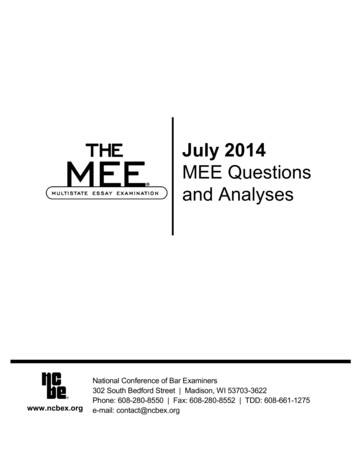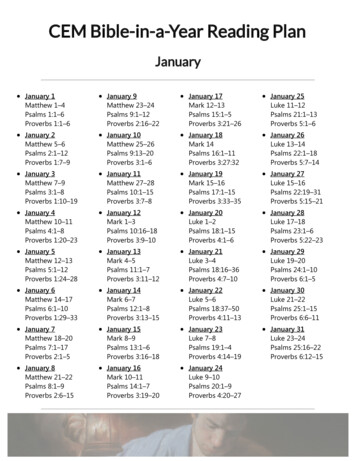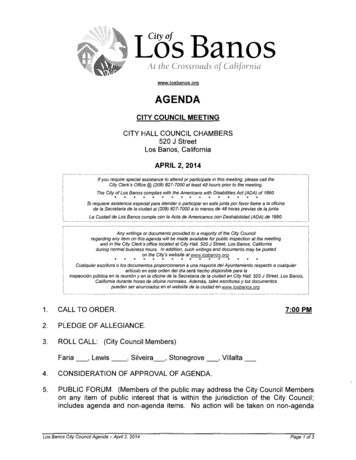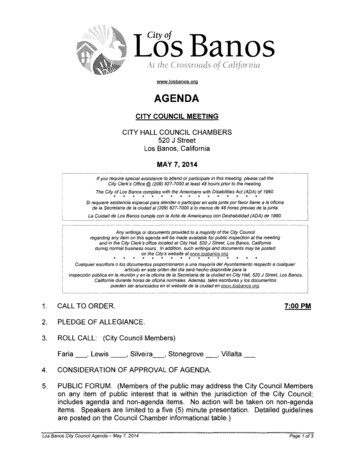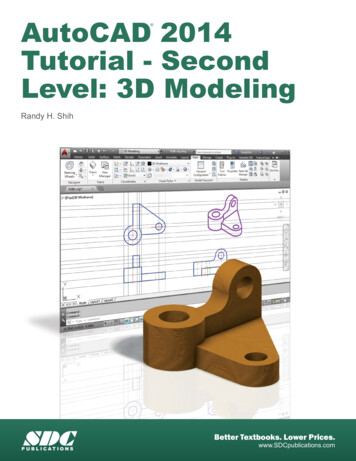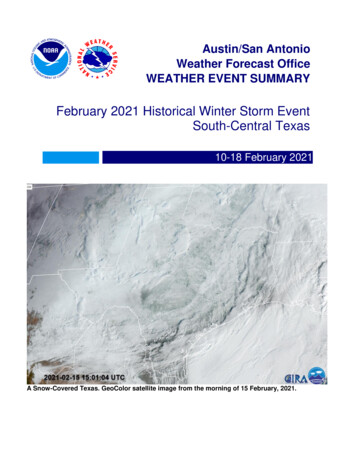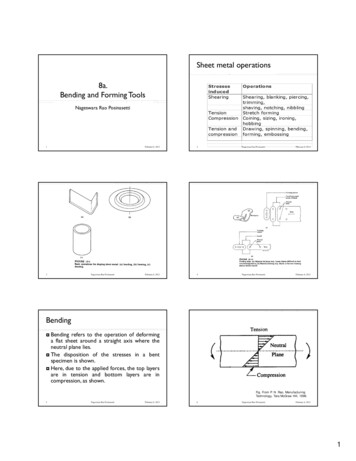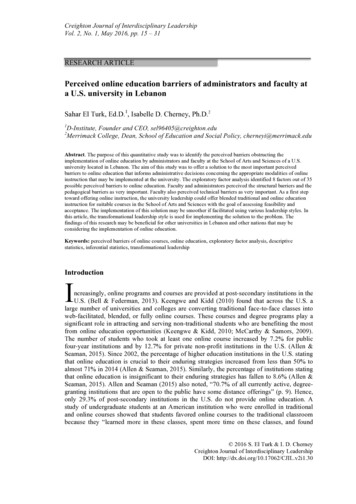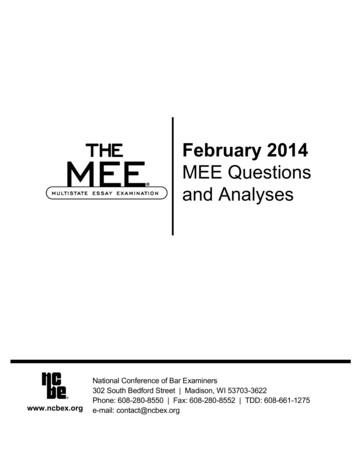
Transcription
February 2014MEE Questionsand Analyseswww.ncbex.orgNational Conference of Bar Examiners302 South Bedford Street Madison, WI 53703-3622Phone: 608-280-8550 Fax: 608-280-8552 TDD: 608-661-1275e-mail: contact@ncbex.org
Copyright 2014 by the National Conference of Bar Examiners.All rights reserved.
ContentsPreface.iiDescription of the MEE .iiInstructions.iiiFebruary 2014 QuestionsConstitutional Law Question . .3Trusts and Future Interests Question . .4Secured Transactions Question. .5Federal Civil Procedure Question . .6Criminal Law and Procedure Question. .7Agency and Partnership Question. .8February 2014 AnalysesConstitutional Law Analysis. 11Trusts and Future Interests Analysis. 14Secured Transactions Analysis . 17Federal Civil Procedure Analysis . 19Criminal Law and Procedure Analysis . 23Agency and Partnership Analysis . 27i
PrefaceThe Multistate Essay Examination (MEE) is developed by the National Conference of BarExaminers (NCBE). This publication includes the questions and analyses from the February2014 MEE. (In the actual test, the questions are simply numbered rather than being identified byarea of law.) The instructions for the test appear on page iii.The model analyses for the MEE are illustrative of the discussions that might appear in excellentanswers to the questions. They are provided to the user jurisdictions to assist graders in gradingthe examination. They address all the legal and factual issues the drafters intended to raise in thequestions.The subjects covered by each question are listed on the first page of its accompanying analysis,identified by roman numerals that refer to the MEE subject matter outline for that subject. Forexample, the Federal Civil Procedure question on the February 2014 MEE tested the followingarea from the Federal Civil Procedure outline: IV.D., Pretrial procedures—Discovery (includinge-discovery).For more information about the MEE, including subject matter outlines, visit the NBCE websiteat www.ncbex.org.Description of the MEEThe MEE consists of six 30-minute essay questions and is a component of the Uniform BarExamination (UBE). It is administered by participating jurisdictions on the Tuesday before thelast Wednesday in February and July of each year. The areas of law that may be covered by thequestions on any MEE are Business Associations (Agency and Partnership; Corporations andLimited Liability Companies), Conflict of Laws, Constitutional Law, Contracts, Criminal Lawand Procedure, Evidence, Family Law, Federal Civil Procedure, Real Property, Torts, Trusts andEstates (Decedents’ Estates; Trusts and Future Interests), and Uniform Commercial Code(Negotiable Instruments and Bank Deposits and Collections; Secured Transactions). Somequestions may include issues in more than one area of law. The particular areas covered varyfrom exam to exam.The purpose of the MEE is to test the examinee’s ability to (1) identify legal issues raised by ahypothetical factual situation; (2) separate material which is relevant from that which is not; (3)present a reasoned analysis of the relevant issues in a clear, concise, and well-organizedcomposition; and (4) demonstrate an understanding of the fundamental legal principles relevantto the probable solution of the issues raised by the factual situation. The primary distinctionbetween the MEE and the Multistate Bar Examination (MBE) is that the MEE requires theexaminee to demonstrate an ability to communicate effectively in writing.ii
InstructionsThe back cover of each test booklet contains the following instructions:You will be instructed when to begin and when to stop this test. Do not break the seal on thisbooklet until you are told to begin.You may answer the questions in any order you wish. Do not answer more than one questionin each answer booklet. If you make a mistake or wish to revise your answer, simply draw aline through the material you wish to delete.If you are using a laptop computer to answer the questions, your jurisdiction will provide youwith specific instructions.Read each fact situation very carefully and do not assume facts that are not given in thequestion. Do not assume that each question covers only a single area of the law; some of thequestions may cover more than one of the areas you are responsible for knowing.Demonstrate your ability to reason and analyze. Each of your answers should show anunderstanding of the facts, a recognition of the issues included, a knowledge of the applicableprinciples of law, and the reasoning by which you arrive at your conclusions. The value ofyour answer depends not as much upon your conclusions as upon the presence and quality ofthe elements mentioned above.Clarity and conciseness are important, but make your answer complete. Do not volunteerirrelevant or immaterial information.Answer all questions according to generally accepted fundamental legal principles unlessyour testing jurisdiction has instructed you to answer according to local case or statutory law.NOTE: Examinees testing in UBE jurisdictions must answer according to generally acceptedfundamental legal principles rather than local case or statutory law.iii
February 2014 MEE QUESTIONSConstitutional LawTrusts and Future InterestsSecured TransactionsFederal Civil ProcedureCriminal Law and ProcedureAgency and Partnership
CONSTITUTIONAL LAW QUESTIONA city ordinance required each downtown business to install high-powered halogen floodlightsthat would illuminate the property owned by that business and the adjoining sidewalks. A studycommissioned by the city estimated that installation of the floodlights would cost a typicalbusiness about 1,000, but that increased business traffic due to enhanced public safety,especially after dark, would likely offset this cost.A downtown restaurant applied to the city for a building permit to construct an addition thatwould increase its seating capacity. In its permit application, the restaurant accurately noted thatits current facility did not have sufficient seating to accommodate all potential customers duringpeak hours. The city approved the permit on the condition that the restaurant grant the city aneasement over a narrow strip of the restaurant’s property, to be used by the city to install videosurveillance equipment that would cover nearby public streets and parking lots. The city basedits permit decision entirely on findings that the increased patronage that would result from theincreased capacity of the restaurant might also attract additional crime to the neighborhood, andthat installing video surveillance equipment might alleviate that problem.The restaurant has challenged both the ordinance requiring it to install floodlights and theeasement condition imposed on approval of the building permit.1.Under the Fifth Amendment as applied to the states through the Fourteenth Amendment,is the city ordinance requiring the restaurant to install floodlights an unconstitutionaltaking? Explain.2.Under the Fifth Amendment as applied to the states through the Fourteenth Amendment,is the city’s requirement that the restaurant grant the city an easement as a condition forobtaining the building permit an unconstitutional taking? Explain.3
TRUSTS AND FUTURE INTERESTS QUESTIONTen years ago, a testator died, survived by his only children: a son, age 26, and a daughter,age 18.A testamentary trust was created under the testator’s duly probated will. The will specified thatall trust income would be paid to the son during the son’s lifetime and that upon the son’s death,the trust would terminate and trust principal would be distributed to the testator’s “grandchildrenwho shall survive” the son. The testator provided for his daughter in other sections of the will.Five years ago, the trustee of the testamentary trust purchased an office building with 500,000from the trust principal. Other than this building, the trust assets consist of publicly tradedsecurities.Last year, the trustee received 30,000 in rents from the office building. The trustee alsoreceived, with respect to the securities owned by the trust, cash dividends of 20,000 and a stockdividend of 400 shares of Acme Corp. common stock distributed to the trust by Acme Corp.Eight months ago, the trustee sold the office building for 700,000.Six months ago, the son delivered a letter to the trustee stating: “I hereby disclaim any interest Imay have in the income interest of the trust.” On the date the son delivered this letter to thetrustee, the son had no living children; the daughter had one living minor child.A statute in this jurisdiction provides that “a disclaimer of any interest created by will is validonly if made within nine months after the testator’s death, and if an interest is validly disclaimed,the disclaiming party is deemed to have predeceased the testator.”1.How should the rents, sales proceeds, cash dividends, and stock dividends received priorto the trustee’s receipt of the son’s letter have been allocated between trust principal andincome? Explain.2.How, if at all, does the son’s letter to the trustee affect the future distribution of trustincome and principal? Explain.4
SECURED TRANSACTIONS QUESTIONOn March 1, the owner of a manufacturing business entered into negotiations with a bank toobtain a loan of 100,000 for the business. The bank loan officer informed the business ownerthat the interest rate for a loan would be lower if the repayment obligation were secured by allthe business’s present and future equipment. The loan officer also informed the business ownerthat the bank could not commit to making the loan until its credit investigation was completed,but that funds could be advanced faster following loan approval if a financing statement withrespect to the transaction were filed in advance. Accordingly, the business owner signed a formon behalf of the business authorizing the bank to file a financing statement with respect to theproposed transaction. The bank properly filed a financing statement the next day, correctlyproviding the name of the business as the debtor and indicating “equipment” as the collateral.On March 15, the business owner had heard nothing from the bank about whether the loan hadbeen approved, so the business owner approached a finance company for a loan. The financecompany quickly agreed to lend 100,000 to the business, secured by all the business’s presentand future equipment. That same day, the finance company loaned to the business 100,000, andthe business owner signed an agreement obligating the business to repay the loan and grantingthe finance company a security interest in all the business’s “present and future equipment” tosecure the repayment obligation. Also on that day, the finance company properly filed afinancing statement correctly providing the business’s name as the debtor and indicating“equipment” as the collateral.On March 21, the bank loan officer contacted the business owner and indicated that the loanapplication had been approved. On the next day, March 22, the bank loaned the business 100,000. The loan agreement, signed by the owner on behalf of the business, granted the bank asecurity interest in all the business’s “present and future equipment.”On April 10, the business sold an item of manufacturing equipment to a competitor for 20,000.This was the first time the business had ever sold any of its equipment. The competitor paid thepurchase price in cash and took possession of the equipment that day. The competitor acted ingood faith at all times and had no knowledge of the business’s prior transactions with the bankand the finance company.The business has defaulted on its obligations with respect to the loans from the bank and thefinance company. Each of them has asserted a claim to all the business’s equipment as well as tothe item of equipment sold to the business’s competitor.Assume that the business owner had the authority to enter into all these transactions on behalf ofthe business.1.As between the bank and the finance company, which has a superior claim to thebusiness’s equipment? Explain.2.Do the claims of the bank and the finance company to the business’s equipment continuein the item of equipment sold to the competitor? Explain.5
FEDERAL CIVIL PROCEDURE QUESTIONA builder constructed a vacation house for an out-of-state customer on the customer’s land. Thehouse was completed on June 1, at which point the customer still owed 200,000 of the 800,000contract price, which was payable in full five days later.On June 14, the basement of the house was flooded with two inches of water during a heavyrainfall. When the customer complained, the builder told the customer, “The flooding was causedby poorly designed landscaping. Our work is fine and fully up to code. Have an engineer look atthe foundation. If there’s a problem, we’ll fix it.”The customer, pleased by the builder’s cooperative attitude, immediately hired a structuralengineer to examine the foundation of the house. On June 30, the engineer provided the customerwith a written report on the condition of the foundation, which stated that the foundation wasproperly constructed.Unhappy with the conclusions in the engineer’s report, the customer then hired a home inspectorto evaluate the house. The home inspector’s report concluded that the foundation of the househad been poorly constructed and was inadequately waterproofed.On July 10, the customer sent the builder the home inspector’s report with a note that said, “Untilyou fix this problem, you won’t get another penny from me.” The builder immediately contactedan attorney and directed the attorney to prepare a draft complaint against the customer fornonpayment. Hoping to avoid litigation, the builder sent several more requests for payment to thecustomer. The customer ignored all these requests.On September 10, the builder filed suit in federal district court, properly invoking the court’sdiversity jurisdiction and seeking 200,000 in damages for breach of contract. The customer’sanswer denied liability on the basis of alleged defective construction of the house’s foundation.Several months later, the case is nearly ready for trial. However, two discovery disputes have notyet been resolved.First, despite a request from the builder, the customer has refused to provide a copy of the reportprepared by the structural engineer who examined the foundation of the house. The customerclaims that the report is “work product” and not discoverable because the customer does notintend to ask the engineer to testify at trial. The builder has asked the court to order the customerto turn over the engineer’s report.Second, the customer has asked the court to impose sanctions for the builder’s failure to complywith the customer’s demand for copies of all emails concerning construction of the foundation ofthe house. The builder has truthfully informed the customer that all such emails were destroyedon August 2. This destruction was pursuant to the builder’s standard practice of permanentlydeleting all project-related emails from company records 60 days after construction of a projectis complete. There is no relevant state records-retention law.1.Should the court order the customer to turn over the engineer’s report? Explain.2.Should the court sanction the builder for the destruction of emails related to the case, andif so, what factors should the court consider in determining those sanctions? Explain.6
CRIMINAL LAW AND PROCEDURE QUESTIONA defendant was charged under state law with felony theft (Class D) and felony residentialburglary (Class C). The indictment alleged that the defendant entered his neighbors’ homewithout their consent and stole a diamond ring worth at least 2,500.Defense counsel filed a pretrial motion to dismiss the charges on the ground that prosecuting thedefendant for both burglary and theft would constitute double jeopardy. The trial court deniedthe motion, and the defendant was prosecuted for both crimes. The only evidence of the ring’svalue offered at the defendant’s jury trial was the owner’s testimony that she had purchased thering two years earlier for 3,000.At trial, the judge issued the following jury instruction on the burglary charge prior todeliberations:If, after consideration of all the evidence presented by the prosecution and defense, youfind beyond a reasonable doubt that the defendant entered the dwelling without theowners’ consent, you may presume that the defendant entered with the intent to commit afelony therein.The jury found the defendant guilty of both offenses.At the defendant’s sentencing hearing, an expert witness called by the prosecutor testified thatthe diamond ring was worth between 7,000 and 8,000. Over defense objection, the judgeconcluded, by a preponderance of the evidence, that the value of the stolen ring exceeded 5,000.The judge sentenced the defendant to four years’ incarceration on the theft conviction. On theburglary conviction, the defendant received a consecutive sentence of seven years’ incarceration.In this state, residential burglary is defined as “entry into the dwelling of another, without theconsent of the lawful resident, with the intent to commit a felony therein.” Residential burglary isa Class C felony for which the minimum sentence is five years and the maximum sentence is tenyears of incarceration.In this state, theft is defined as “taking and carrying away the property of another with the intentto permanently deprive the owner of possession.” Theft is a Class D felony if the value of theitem(s) taken is between 2,500 and 10,000. The sentence for a Class D felony theft isdetermined by the value of the items taken. If the value is between 2,500 and 5,000, themaximum sentence is three years’ incarceration. If the value of the items exceeds 5,000, themaximum sentence is five years’ incarceration.This state affords a criminal defendant no greater rights than those mandated by the UnitedStates Constitution.1.Did the trial court err when it denied the defendant’s pretrial motion to dismiss on doublejeopardy grounds? Explain.2.Did the trial court err in its instruction to the jury on the burglary charge? Explain.3.Did the trial court err when it sentenced the defendant to an additional year ofincarceration on the theft conviction based on the expert’s testimony? Explain.7
AGENCY AND PARTNERSHIP QUESTIONFive years ago, Adam and Ben formed a general partnership, Empire Partnership (Empire),buy and sell antique automobiles at a showroom in State A. Adam contributed 800,000Empire, and Ben contributed 200,000. Their written partnership agreement allocated 80%profits, losses, and control to Adam and 20% to Ben. No filings of any type were madeconnection with the formation of Empire.totoofinThree years ago, a collector purchased one of Empire’s antique cars for 3,400,000. Thecollector was willing to pay this price because of Ben’s false representation (repeated in the salescontract) that a famous movie star had once owned the car. Without the movie-star connection,the car was worth only 100,000. One month later, when the collector discovered the truth, hesued Adam, Ben, and Empire for 3,300,000 in damages. The lawsuit is still pending.Two years ago, Adam and Ben admitted a new partner, Diane, to Empire in return for hercontribution of 250,000. The three agreed to allocate profits, losses, and control 75% to Adam,10% to Ben, and 15% to Diane. Before joining the partnership, Diane learned of the collector’sclaim and stated her concern to Adam and Ben that she might become liable if the claim werereduced to a judgment.Following Diane’s admission to Empire, the three partners sought to convert Empire into alimited liability partnership (LLP). Adam’s lawyer proposed to file with State A a “statement ofqualification” making an LLP election and declaring the name of the partnership to be “EmpireLLP.” Ben’s lawyer stated that this would not work and that a new LLP had to be formed, withthe assets of the old partnership transferred to the new one. In the end, the conversion was donethe way Adam’s lawyer suggested with the approval of all three partners.One year ago, a driver purchased a vintage car from Empire LLP, based on the representationthat the car was “fully roadworthy and capable of touring at 70 mph all day.” The driver took thecar on the highway at 50 mph, whereupon the front suspension collapsed, resulting in a crash inwhich the car was destroyed and the driver killed. The driver’s estate sued Adam, Ben, Diane,and Empire LLP for 10,000,000. The lawsuit is still pending.Although profitable, Empire LLP does not have resources sufficient to pay the collector’s claimor the claim of the driver’s estate.Assume that the Uniform Partnership Act (1997) applies.1.Before the filing of the statement of qualification,(a)was Adam personally liable on the collector’s claim? Explain.(b)was Diane personally liable on the collector’s claim? Explain.2.After the filing of the statement of qualification, was Adam, Ben, or Diane personallyliable as a partner on (a) the collector’s claim or (b) the driver’s estate’s claim? Explain.8
February 2014 MEE ANALYSESConstitutional LawTrusts and Future InterestsSecured TransactionsFederal Civil ProcedureCriminal Law and ProcedureAgency and Partnership
CONSTITUTIONAL LAW ANALYSIS(Constitutional Law IV.D.)ANALYSISLegal Problems(1) Is the city ordinance requirement that businesses install floodlights a taking?(2) Is conditioning the approval of a building permit on the grant of an easement to installsurveillance equipment a taking of property?DISCUSSIONSummaryThe ordinance requiring businesses to install floodlights is not a per se taking under Loretto,because it does not force a private landowner to allow a third party to enter and place a physicalobject on the land. Here, the city ordinance requires the business—not a third party—to installthe floodlights.The ordinance is likely not a regulatory taking under the Penn Central balancing test.While the ordinance will impose a cost on business owners, that cost may be offset by theexpected increase in business due to the ordinance, and the ordinance does not appear to interferewith the owner’s primary use of the property as a restaurant.The permit condition, however, is likely an uncompensated taking of property. While thecondition has an essential nexus with the city’s legitimate interest in promoting public safety, thecity has not made an individualized determination that the easement condition is roughlyproportional to the possibility of increased crime due to the restaurant’s proposed addition. Thus,the permit condition likely violates the Fifth Amendment as applied to the states through theFourteenth Amendment.Point One (50%)The ordinance requiring that businesses install floodlights is not a per se taking under Loretto. Itis not a regulatory taking under the Penn Central balancing test because the cost of compliancewith the ordinance may be offset by an expected increase in business and compliance does notinterfere with the business’s primary use of its property as a restaurant.The city ordinance requiring a business to install floodlights does not effect a per se taking of thesort described in Loretto v. Teleprompter Manhattan CATV Corp., 458 U.S. 419 (1982), becauseno property is physically taken by the government and the ordinance does not involve a physicalinvasion of private property by a third party.Even though the ordinance does not constitute an occupation of the property by either thegovernment or a third party, it is still subject to the three-factor balancing test under PennCentral Transportation Co. v. City of New York, 438 U.S. 104 (1978), to determine whether it isa “regulatory taking.” Under Penn Central, a court must balance (1) “[t]he economic impact ofthe regulation on the claimant,” (2) “the extent to which the regulation has interfered withdistinct investment-backed expectations,” and (3) “the character of the governmental action.” Id.at 124. Here, each factor weighs against finding that the ordinance is a taking.11
Constitutional Law AnalysisFirst, the ordinance requirement likely has a minimal economic impact on the restaurant.Compliance with the ordinance is estimated to cost 1,000, and the city has found that businesseswill likely recoup that cost in increased sales. Also, because the ordinance does not interfere withthe operation of the restaurant, the owner may still earn a reasonable return on its investment inthe property.Second, the ordinance does not interfere with the business’s investment-backedexpectations. As in Penn Central, the challenged law does not interfere with the owner’s“primary expectation” for use of the property—in Penn Central, as a railroad terminal, and here,as a restaurant. Further, the ordinance does not prevent the restaurant from expanding to meet thechanging business environment.Third, the character of the government action does not weigh in favor of a taking. WhilePenn Central does say that a “physical invasion” is more likely to pose a taking, Loretto suggeststhat the Court’s main concern is with physical invasions by third parties. Also, like the landmarklaw challenged in Penn Central, the ordinance here “adjust[s] the benefits and burdens ofeconomic life to promote the common good.” Id. In Penn Central, the landmark law restricteddevelopment of the railroad terminal to promote the common interest in preserving historiclandmarks. Here, the ordinance requires the businesses to install floodlights to promote thecommon interest in crime prevention and public safety.Because the ordinance is clearly a valid exercise of the police power, it satisfies thetakings clause’s public-use requirement. Kelo v. City of New London, 545 U.S. 469 (2005).In sum, all three factors weigh against finding a taking under the Penn Central balancingtest.Point Two (50%)The permit condition may be unconstitutional as an uncompensated taking of property becausethe city has not made an individualized determination that the easement condition is roughlyproportional to the impact of the restaurant’s proposed addition.In Dolan v. City of Tigard, 512 U.S. 374 (1994), the Supreme Court set forth the test fordetermining whether an exaction imposed by a government in exchange for a discretionarybenefit conferred by the government, such as a condition on the approval of a building permit inthis case, constitutes an uncompensated taking under the Fifth Amendment. The exaction is not ataking if (1) there is an “essential nexus” between the “public need or burden” to which theproposed development contributes and “the permit condition exacted by the city,” id. at 386, and(2) the government makes “some sort of individualized determination that the requireddedication is [roughly proportional] both in nature and extent to the impact of the proposeddevelopment.” Id. at 391; see also Nollan v. California Coastal Commission, 483 U.S. 825(1987).Here, the city likely can meet the nexus requirement. In Dolan, the landowner sought todouble the size of its business, which would have increased traffic on nearby roadways. Inexchange for approving the development, the city sought an easement for a bike and pedestrianpath. The Court found the required nexus between the easement and the city’s “attempt to reducetraffic congestion by providing for alternative means of transportation.” 512 U.S. at 387. Here, asimilar nexus likely exists between the requested easement and the city’s interest in crimeprevention and public safety. Increased patronage and economic activity at the restaurant mightattract additional crime to the area, and the requested easement to install surveillance equipmentwould attempt to address that increased crime.12
Constitutional Law AnalysisThe exaction here, however, may fail the second prong of the Dolan test—that theexaction be roughly proportional to the anticipated impact of the requested development. Asnoted, the city in Dolan claimed that a bike and pedestrian path was needed to offset the increasein traffic due to the proposed doubling of the business. The Court explained that the governmentmust demonstrate that the additional traffic reasonably was related to the requested exaction andthat the government must “make some effort to quantify its findings in support of the dedicationfor the pedestrian/bicycle pathway beyond the conclusory statement that it could offset some ofthe traffic demand generated.” Id. at 395. Here, the ci
Examiners (NCBE). This publication includes the questions and analyses from the February 2014 MEE. (In the actual test, the questions are simply numbered rather than being identified by area of law.) The instructions for the test appear on page iii. The model analyses for the MEE are illustrative of the discussions that might appear in excellent

